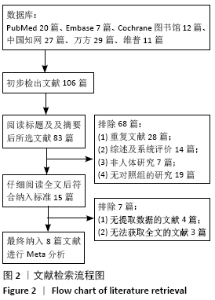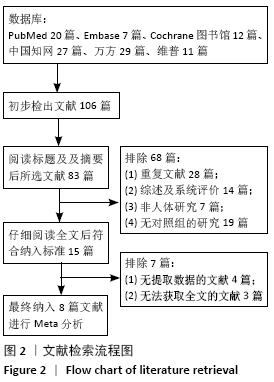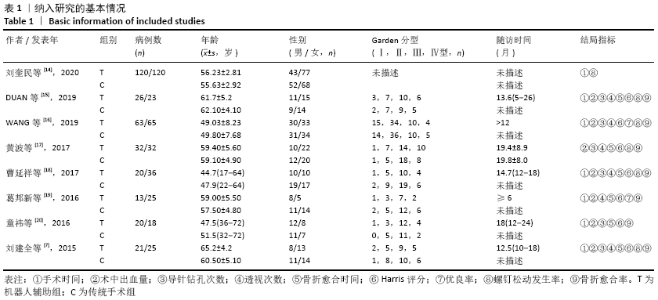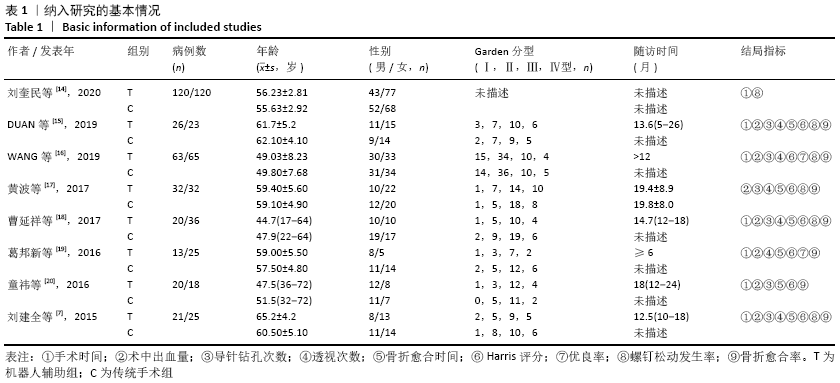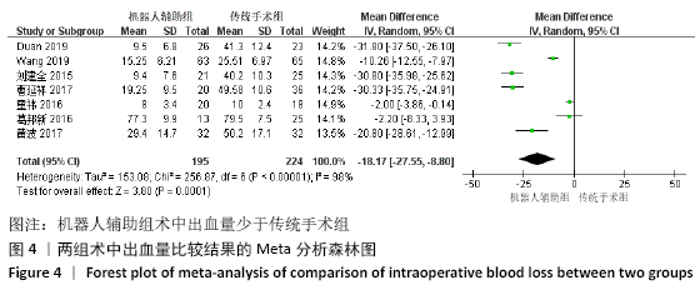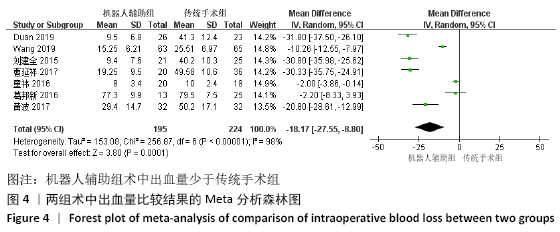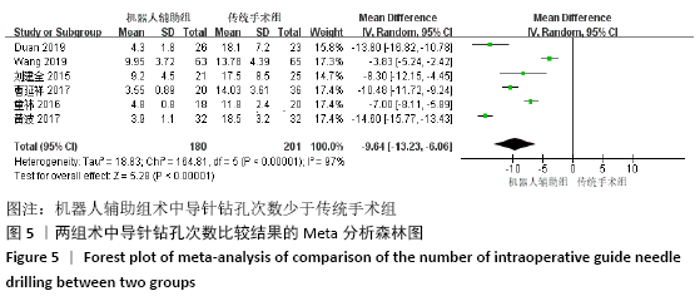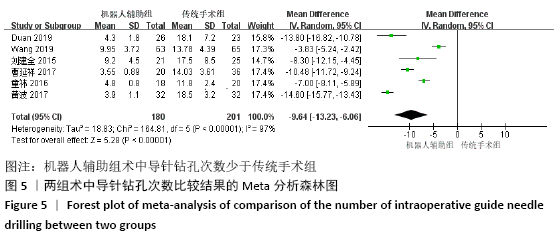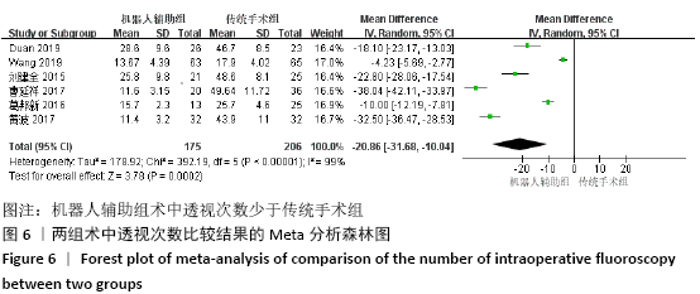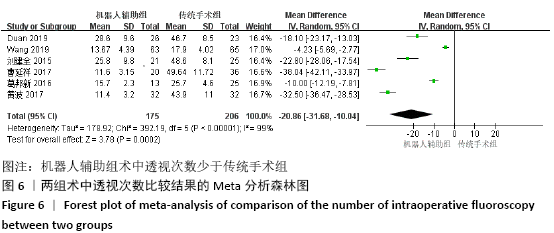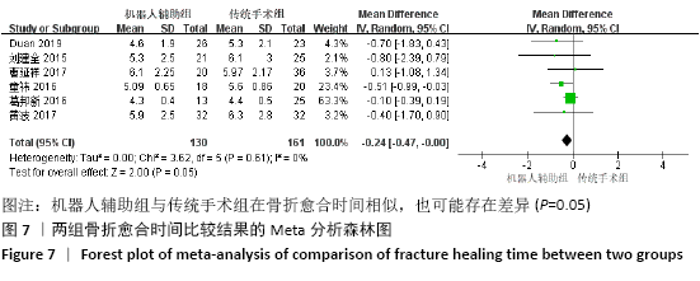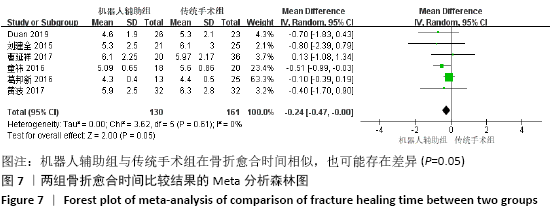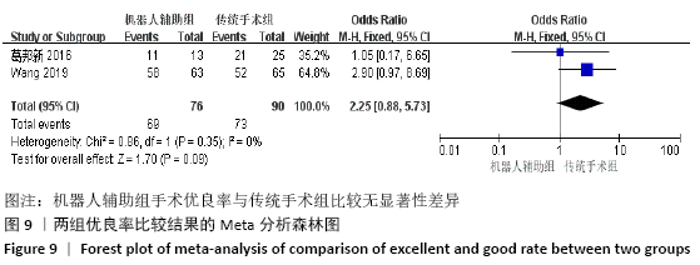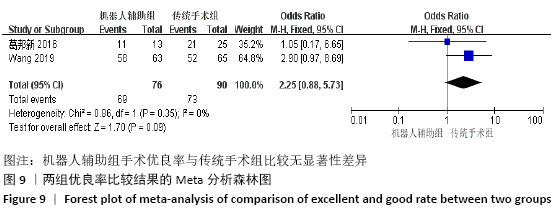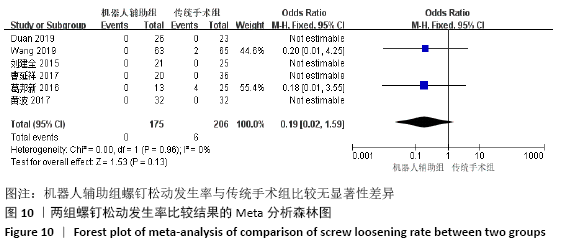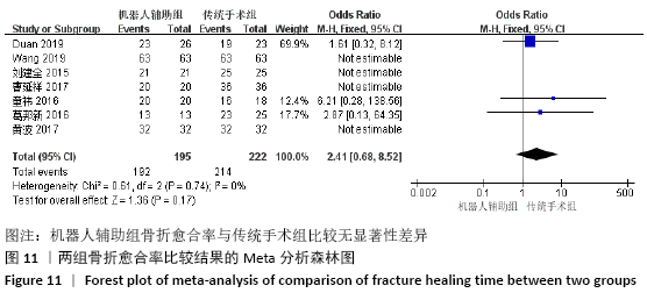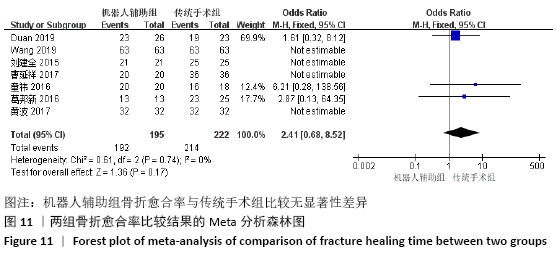Chinese Journal of Tissue Engineering Research ›› 2021, Vol. 25 ›› Issue (18): 2938-2944.doi: 10.3969/j.issn.2095-4344.3849
Previous Articles Next Articles
Meta-analysis of the efficacy of robot-assisted and traditional manual implantation of cannulated screws in the treatment of femoral neck fracture
Yang Kun1, Fei Chen1, Wang Pengfei2, Zhang Binfei2, Yang Na2, Tian Ding2, Zhuang Yan2, Zhang Kun2
- 1Graduate School of Xi’an Medical University, Xi’an 710068, Shaanxi Province, China; 2Department of Orthopedics Trauma, Honghui Hospital, Xi’an Jiaotong University, Xi’an 710054, Shaanxi Province, China
-
Received:2020-07-13Revised:2020-07-17Accepted:2020-09-05Online:2021-06-28Published:2021-01-12 -
Contact:Zhang Kun, Chief physician, Master’s supervisor, Department of Orthopedics Trauma, Honghui Hospital, Xi’an Jiaotong University, Xi’an 710054, Shaanxi Province, China -
About author:Yang Kun, Master candidate, Physician, Graduate School of Xi’an Medical University, Xi’an 710068, Shaanxi Province, China -
Supported by:the Natural Science Foundation of Shaanxi Province, No. 2017ZDXM-SF-009 (to ZK)
CLC Number:
Cite this article
Yang Kun, Fei Chen, Wang Pengfei, Zhang Binfei, Yang Na, Tian Ding, Zhuang Yan, Zhang Kun . Meta-analysis of the efficacy of robot-assisted and traditional manual implantation of cannulated screws in the treatment of femoral neck fracture[J]. Chinese Journal of Tissue Engineering Research, 2021, 25(18): 2938-2944.
share this article
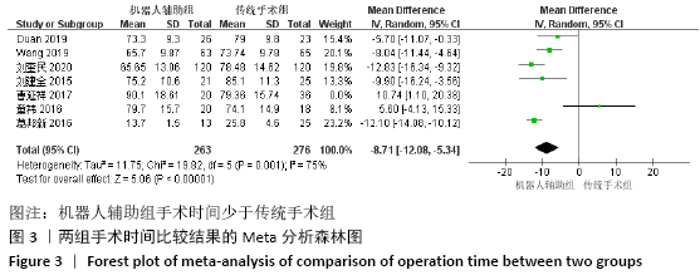
2.3 Meta分析结果 2.3.1 各组手术时间差异 纳入研究的文献中有7篇报道了手术时间[7,14-16,18-20]。异质性分析显示,各研究结果显示存在明显异质性(P < 0.000 01,I2=84%),通过逐篇剔除文献的方法进行敏感性分析,剔除1篇文献后发现异质性下降明显但仍较高(I2=75%)[18],经阅读全文后发现,该篇机器人辅助组螺钉规划不支持同时规划3枚螺钉路径,导致机器人辅助组手术时间延长,另外临床医生对于机器人辅助系统的熟悉程度不同也导致研究间异质性较大。经过敏感性分析后森林图结构改变不明显,故采用随机效应模型分析,结果显示机器人辅助组平均手术时间小于传统手术组(MD= -8.71,95%CI:-12.08至-5.34,P < 0.000 01),见图3。 "
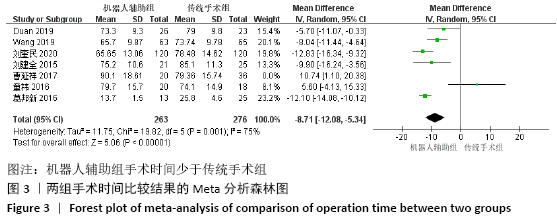
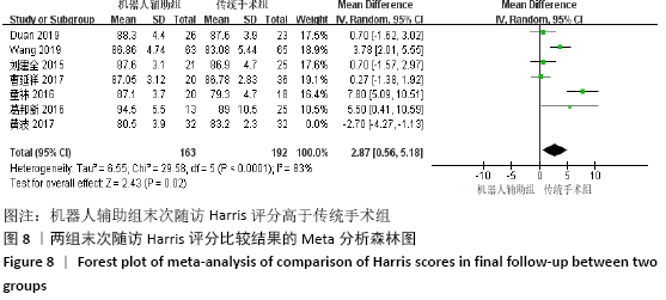
2.3.6 各组末次随访Harris评分差异 纳入研究的文献中有7篇报道了末次随访的髋关节Harris评分[7,15-20]。异质性分析显示,各研究结果显示存在明显异质性(P < 0.000 01,I2=90%),剔除其中1篇文献后发现异质性明显下降(I2=83%)[17],同时Meta分析结果也发生改变,分析原因为该篇文献所纳入复杂骨折类型-Garden Ⅳ型例数最多(28%),对于术后髋关节Harris评分结果产生偏倚,同时随访时间不同也可导致各研究间异质性较大,故采用随机效应模型分析,结果显示机器人辅助组平均髋关节Harris评分优于传统手术组(MD=2.87,95%CI:0.56-5.18,P=0.02),见图8。有2篇文献使用髋关节Harris评分对置入螺钉效果进行优良率评价[16,19],异质性分析显示,各研究结果显示不存在异质性(P=0.35,I2=0%),故采用固定效应模型分析,结果显示机器人辅助组平均优良率与传统手术组相似,差异无显著性意义(OR=2.25,95%CI:0.88-5.73,P=0.09),见图9。 "
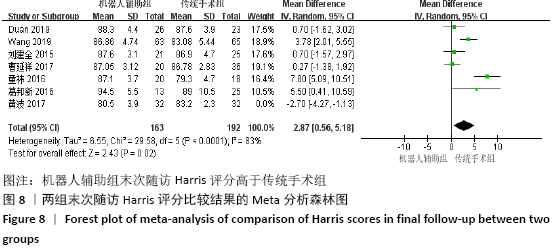
| [1] GROSSMAN DC, CURRY SJ, OWENS DK, et al. Vitamin D, calcium, or combined supplementation for the primary prevention of fractures in community-dwelling adults. JAMA. 2018;319(15):1592. [2] THORNGREN KG, HOMMEL A, NORRMAN PO, et al. Epidemiology of femoral neck fractures. Injury. 2002;33 Suppl 3:C1-C7. [3] PAUYO T, DRAGER J, ALBERS A, et al. Management of femoral neck fractures in the young patient: a critical analysis review. World J Orthop. 2014;5(3):204-217. [4] SELVAN VT, OAKLEY MJ, RANGAN A, et al. Optimum configuration of cannulated hip screws for the fixation of intracapsular hip fractures: a biomechanical study. Injury. 2004;35(2):136-141. [5] SONG J, DING H, HAN W, et al. A motion compensation method for bi-plane robot-assisted internal fixation surgery of a femur neck fracture. Proc Inst Mech Eng H. 2016;230(10):942-948. [6] REGLING M, BLAU A, PROBE RA, et al. A motion compensation method for bi-plane robot-assisted internal fixation surgery of a femur neck fracture. Proc Inst Mech Eng H. 2016;230(10):942-948. [7] 刘建全,刘黎军,黄俊锋,等.机器人导航定位系统辅助下经皮空心螺钉内固定治疗股骨颈骨折[J].中华创伤骨科杂志,2015,17(8):692-698. [8] KARTHIK K, COLEGATE-STONE T, DASGUPTA P, et al. Robotic surgery in trauma and orthopaedics: a systematic review. Bone Joint J. 2015;97-B(3):292-299. [9] ZHENG G, NOLTE LP. Computer-assisted orthopedic surgery: current state and future perspective. Front Surg. 2015;2(10):66. [10] SCHEP NW, HEINTJES RJ, MARTENS EP, et al. Retrospective analysis of factors influencing the operative result after percutaneous osteosynthesis of intracapsular femoral neck fractures. Injury. 2004;35(10):1003-1009. [11] 钱学峰,徐能,蒋富贵,等.经皮空心螺钉内固定治疗股骨颈骨折[J].中华创伤骨科杂志, 2013,15(5):453-454. [12] RAAYMAKERS EL. Fractures of the femoral neck: a review and personal statement. Acta Chir Orthop Traumatol Cech. 2006;73(1):45-59. [13] STANG A. Fractures of the femoral neck: a review and personal statement. Acta Chir Orthop Traumatol Cech. 2006;73(1):45-59. [14] 刘奎民,姜传强,孙涛,等.天矶骨科手术机器人与传统手术治疗股骨颈骨折的直接经济负担比较[J].骨科临床与研究杂志,2020,5(3):143-145. [15] DUAN SJ, LIU HS, WU WC, et al. Robot-assisted percutaneous cannulated screw fixation of femoral neck fractures: preliminary clinical results. Orthop Surg. 2019;11(1):34-41. [16] WANG XD, LAN H, LI KN, et al. Treatment of femoral neck fractures with cannulated screw invasive internal fixation assisted by orthopaedic surgery robot positioning system. Orthop Surg. 2019;11(5):864-872. [17] 黄波,荣绍远,李建华,等.双平面机器人导航辅助下空心钉内固定治疗股骨颈骨折[J].中华骨科杂志,2017,37(9):528-534. [18] 曹延祥,赵燕鹏,胡磊,等.基于误差纠正算法的计算机辅助股骨颈骨折空心螺钉内固定系统的临床应用研究[J].中国修复重建外科杂志,2017,31(3):257-261. [19] 葛邦新,段军富,王博,等.骨科机器人导航定位系统在股骨颈骨折空心螺钉内固定术中的应用价值[J].新乡医学院学报,2016,33(12): 1085-1087,1090. [20] 童祎,罗晓中,吴刚,等.机器人导航下及传统经皮空心拉力螺钉内固定术治疗股骨颈骨折的疗效比较[J].中国修复重建外科杂志, 2016,30(6):685-689. [21] 许新忠,常菁,余水生,等.股骨颈系统固定治疗股骨颈骨折的近期疗效分析[J].中华创伤骨科杂志,2020,22(7):624-627. [22] 王军强,樊瑜波.计算机辅助骨科手术技术将改善股骨颈骨折治疗[J].中国骨伤,2018,31(2): 99-102. [23] WANG JQ, ZHAO CP, SU YG, et al. Computer-assisted navigation systems for insertion of cannulated screws in femoral neck fractures: a comparison of bi-planar robot navigation with optoelectronic navigation in a Synbone hip model trial. Chin Med J. 2011;124(23):3906-3911. [24] 赵春鹏,王军强,王豫,等.双平面骨科机器人系统辅助股骨颈骨折空心螺钉内固定术的实验研究[J].中华创伤骨科杂志,2006,8(1):50-55. [25] 王满宜,危杰.股骨颈骨折临床研究的若干问题与新概念[J].中华创伤骨科杂志,2003,5(1):5-9. [26] 吴静,茅金宝,孔祥云,等.导航与普通透视对手术室医务人员放射量的对比分析[J].医学影像学杂志,2013,23(10):1631-1634. [27] GOSLING T, WESTPHAL R, HUFNER T, et al. Robot-assisted fracture reduction: a preliminary study in the femur shaft. Med Biol Eng Comput. 2005;43(1):115-120. [28] ZLOWODZKI M, BRINK O, SWITZER J, et al. The effect of shortening and varus collapse of the femoral neck on function after fixation of intracapsular fracture of the hip: a multi-centre cohort study. J Bone Joint Surg Br. 2008;90(11):1487-1494. [29] HE M, HAN W, ZHAO CP, et al. Evaluation of a bi-planar robot navigation system for insertion of cannulated screws in femoral neck fractures. Orthop Surg. 2019;11(3):373-379. [30] FILIPOV O, GUEORGUIEV B. Unique stability of femoral neck fractures treated with the novel biplane double-supported screw fixation method: a biomechanical cadaver study. Injury. 2015;46(2):218-226. [31] FILIPOV O, STOFFEL K, GUEORGUIEV B, et al. Femoral neck fracture osteosynthesis by the biplane double-supported screw fixation method (BDSF) reduces the risk of fixation failure: clinical outcomes in 207 patients. Arch Orthop Trauma Surg. 2017;137(6):779-788. [32] 何猛,张腾,韩巍,等.双平面骨科机器人辅助股骨颈骨折空心钉内固定[J].骨科临床与研究杂志,2018,3(4):195-199. |
| [1] | Xu Feng, Kang Hui, Wei Tanjun, Xi Jintao. Biomechanical analysis of different fixation methods of pedicle screws for thoracolumbar fracture [J]. Chinese Journal of Tissue Engineering Research, 2021, 25(9): 1313-1317. |
| [2] | Jiang Yong, Luo Yi, Ding Yongli, Zhou Yong, Min Li, Tang Fan, Zhang Wenli, Duan Hong, Tu Chongqi. Von Mises stress on the influence of pelvic stability by precise sacral resection and clinical validation [J]. Chinese Journal of Tissue Engineering Research, 2021, 25(9): 1318-1323. |
| [3] | Zhang Tongtong, Wang Zhonghua, Wen Jie, Song Yuxin, Liu Lin. Application of three-dimensional printing model in surgical resection and reconstruction of cervical tumor [J]. Chinese Journal of Tissue Engineering Research, 2021, 25(9): 1335-1339. |
| [4] | Zhang Yu, Tian Shaoqi, Zeng Guobo, Hu Chuan. Risk factors for myocardial infarction following primary total joint arthroplasty [J]. Chinese Journal of Tissue Engineering Research, 2021, 25(9): 1340-1345. |
| [5] | Wei Wei, Li Jian, Huang Linhai, Lan Mindong, Lu Xianwei, Huang Shaodong. Factors affecting fall fear in the first movement of elderly patients after total knee or hip arthroplasty [J]. Chinese Journal of Tissue Engineering Research, 2021, 25(9): 1351-1355. |
| [6] | Wang Jinjun, Deng Zengfa, Liu Kang, He Zhiyong, Yu Xinping, Liang Jianji, Li Chen, Guo Zhouyang. Hemostatic effect and safety of intravenous drip of tranexamic acid combined with topical application of cocktail containing tranexamic acid in total knee arthroplasty [J]. Chinese Journal of Tissue Engineering Research, 2021, 25(9): 1356-1361. |
| [7] | Xiao Guoqing, Liu Xuanze, Yan Yuhao, Zhong Xihong. Influencing factors of knee flexion limitation after total knee arthroplasty with posterior stabilized prostheses [J]. Chinese Journal of Tissue Engineering Research, 2021, 25(9): 1362-1367. |
| [8] | Huang Zexiao, Yang Mei, Lin Shiwei, He Heyu. Correlation between the level of serum n-3 polyunsaturated fatty acids and quadriceps weakness in the early stage after total knee arthroplasty [J]. Chinese Journal of Tissue Engineering Research, 2021, 25(9): 1375-1380. |
| [9] | Zhang Chong, Liu Zhiang, Yao Shuaihui, Gao Junsheng, Jiang Yan, Zhang Lu. Safety and effectiveness of topical application of tranexamic acid to reduce drainage of elderly femoral neck fractures after total hip arthroplasty [J]. Chinese Journal of Tissue Engineering Research, 2021, 25(9): 1381-1386. |
| [10] | Wang Haiying, Lü Bing, Li Hui, Wang Shunyi. Posterior lumbar interbody fusion for degenerative lumbar spondylolisthesis: prediction of functional prognosis of patients based on spinopelvic parameters [J]. Chinese Journal of Tissue Engineering Research, 2021, 25(9): 1393-1397. |
| [11] | Lü Zhen, Bai Jinzhu. A prospective study on the application of staged lumbar motion chain rehabilitation based on McKenzie’s technique after lumbar percutaneous transforaminal endoscopic discectomy [J]. Chinese Journal of Tissue Engineering Research, 2021, 25(9): 1398-1403. |
| [12] | Chen Xinmin, Li Wenbiao, Xiong Kaikai, Xiong Xiaoyan, Zheng Liqin, Li Musheng, Zheng Yongze, Lin Ziling. Type A3.3 femoral intertrochanteric fracture with augmented proximal femoral nail anti-rotation in the elderly: finite element analysis of the optimal amount of bone cement [J]. Chinese Journal of Tissue Engineering Research, 2021, 25(9): 1404-1409. |
| [13] | Du Xiupeng, Yang Zhaohui. Effect of degree of initial deformity of impacted femoral neck fractures under 65 years of age on femoral neck shortening [J]. Chinese Journal of Tissue Engineering Research, 2021, 25(9): 1410-1416. |
| [14] | Zhang Shangpu, Ju Xiaodong, Song Hengyi, Dong Zhi, Wang Chen, Sun Guodong. Arthroscopic suture bridge technique with suture anchor in the treatment of acromioclavicular dislocation [J]. Chinese Journal of Tissue Engineering Research, 2021, 25(9): 1417-1422. |
| [15] | Liang Yan, Zhao Yongfei, Xu Shuai, Zhu Zhenqi, Wang Kaifeng, Liu Haiying, Mao Keya. Imaging evaluation of short-segment fixation and fusion for degenerative lumbar scoliosis assisted by highly selective nerve root block [J]. Chinese Journal of Tissue Engineering Research, 2021, 25(9): 1423-1427. |
| Viewed | ||||||
|
Full text |
|
|||||
|
Abstract |
|
|||||
